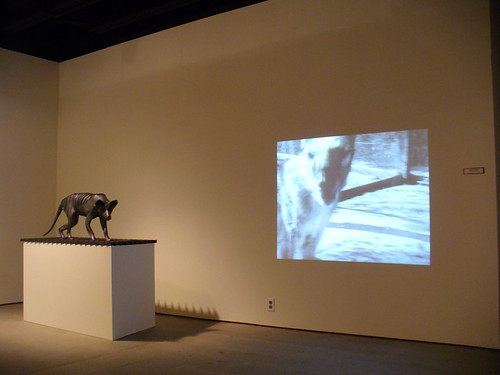
Some cool date for sex images:
2006-12-15 - KC-Artspace - Cryptozoology-0110

Image by smiteme
From the exhibition Cryptozoology: Out of Time Place Scale, as shown at the Kansas City Art Institute's Artspace, October 28 - December 20, 2006:
A marginalized practice or a farcical adventure, cryptozoology is the quest for unknown, rumored, or hidden animals. Three themes are traced through the exhibition and catalog: Artists, Adventurers, Environmentalists; History of Science, Taxonomy, Dioramas, and Museum Displays; and Pop Culture, Myth, Spectacle, and Fraud. The exhibition is organized by the H&R Block Artspace at the Kansas City Art Institute and Lewiston Maine’s Bates College Museum of Art.
The exhibition is curated by Mark H. C. Bessire and Raechell Smith and organized by the Bates College Museum of Art and H & R Block Artspace.
Artists include: Rachel Berwick, Sarina Brewer, Walmor Correa, Mark Dion, Sean Foley, Ellen Lesperance, Robert Marbury, Jill Miller, Vic Muniz, Jeanine Oleson, Rosamond Purcell, Alexis Rockman, Marc Swanson, Jeffrey Vallance and Jamie Wyeth.
--------------
V for Vegan: www.easyvegan.info > Banner Credits
Karma
The Thylacine
was the largest known carnivorous marsupial of modern times. It is commonly known as the Tasmanian Tiger (because of its striped back), the Tasmanian Wolf, and colloquially the Tassie (or Tazzy) Tiger or simply the Tiger. Native to continental Australia, Tasmania and New Guinea, it is thought to have become extinct in the 20th century. It was the last extant member of its genus, Thylacinus, although several related species have been found in the fossil record dating back to the early Miocene.
The Thylacine became extinct on the Australian mainland thousands of years before European settlement of the continent, but it survived on the island state of Tasmania along with several other endemic species, including the Tasmanian Devil. Intensive hunting encouraged by bounties is generally blamed for its extinction, but other contributory factors may have been disease, the introduction of dogs, and human encroachment into its habitat. Despite its official classification as extinct, sightings are still reported. [...]
The last captive Thylacine, later referred to as "Benjamin" (although its sex has never been confirmed) was captured in 1933 and sent to the Hobart Zoo where it lived for three years. [...] This Thylacine died on 7 September 1936. It is believed to have died as the result of neglectâ€"locked out of its sheltered sleeping quarters, it was exposed to a rare occurrence of extreme Tasmanian weather: extreme heat during the day and freezing temperatures at night. This Thylacine features in the last known motion picture footage of a living specimen: 62 seconds of black-and-white footage showing it pacing backwards and forwards in its enclosure in a clip taken in 1933 by naturalist David Fleay. National Threatened Species Day has been held annually since 1996 on 7 September in Australia, to commemorate the death of the last officially recorded Thylacine. [...]
The Thylacine held the status of endangered species until 1986. International standards state that any animal for which no specimens have been recorded for 50 years is to be declared extinct. Since no definitive proof of the Thylacine's existence had been found since "Benjamin" died in 1936, it met that official criterion and was declared officially extinct by the International Union for Conservation of Nature.
In December '06, Shane and I caught the exhibit Cryptozoology: Out of Time Place Scale at the Kansas City Art Institute's Artspace. While most of the pieces dealt with cryptids - animals thought, but not proven to exist - one exhibit caught my eye.
In front of a projection screen sat a statute of the Tasmanian Tiger (pictured below). There playing, on a never ending loop, was the 62 seconds of Benjamin's life immortalized on film. 62 long, lonely seconds, spent pacing - in what? Frustration? Anger? Sadness? Boredom? Heartbreak? Only to die of human neglect, one of the last of her kind. I found the footage haunting then; I still do, upon recollection.
As an atheist, I don’t believe in unprovable religious concepts like karma. As an animal advocate, I sometimes wish I did.

Similar posts to:
20061215:
Cryptozoology0110:
KCArtspace:
No comments:
Post a Comment
Note: Only a member of this blog may post a comment.